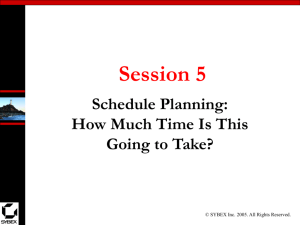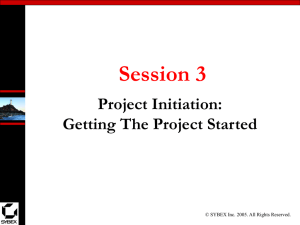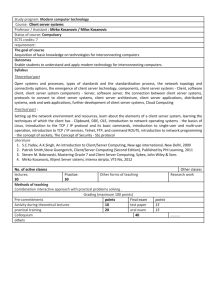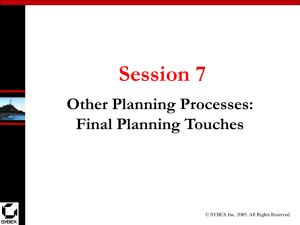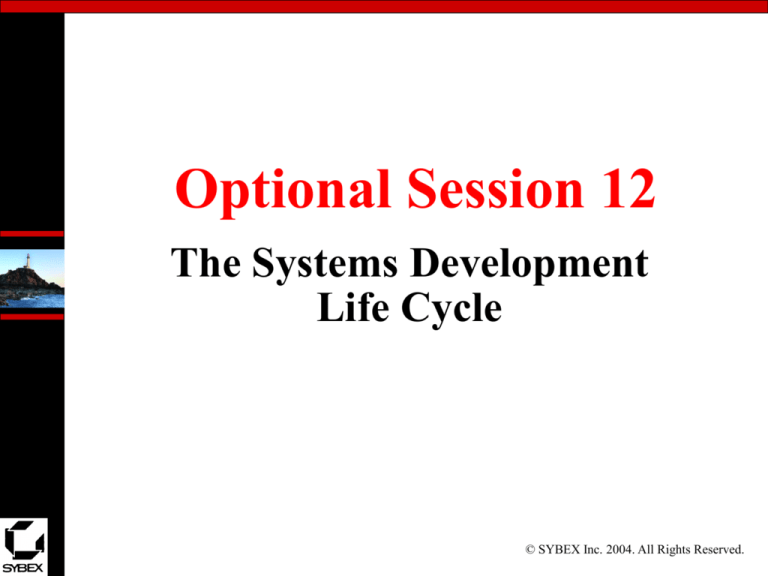
Optional Session 12
The Systems Development
Life Cycle
© SYBEX Inc. 2004. All Rights Reserved.
Learning Objectives
• Understand the difference between SDLC and
the PMI Process Groups
© SYBEX Inc. 2004. All Rights Reserved.
The SDLC/PMI Mixup
Phenomenon
• Some colleges offer Systems Design
and Implementation courses as part of
an IT curriculum
• In this class students might learn about
SDLC
• SDLC has slightly different phases than
PMI’s process groups
• Understanding the differences can help
you with your project management
© SYBEX Inc. 2004. All Rights Reserved.
The SDLC Phases
•
•
•
•
•
Planning
Analysis
Design
Implementation
Operation and Support
© SYBEX Inc. 2004. All Rights Reserved.
Planning and Analysis
• Planning
– Formal request
– Preliminary investigation
– Feasibility analysis
• Analysis
– Requirements gathering
– System requirements documentation
Review the “Getting Your Hands Dirty with SDLC – Planning and Analysis”
section of the case study – page 346
© SYBEX Inc. 2004. All Rights Reserved.
Design
• Think “blueprint”
• Systems are broken down into successively
smaller levels until discrete working entities are
denoted
• Describe each of those entities and how they
interface with their partner components to make
the whole
Review the “Getting Your Hands Dirty with SDLC – Design” section of the case
study – page 347
© SYBEX Inc. 2004. All Rights Reserved.
You Decide
• You’re building a shed.
– What are the smallest subcomponents to the construction
project that you can describe?
• You’re building a gingerbread house for a
competition.
– What are the smallest subcomponents to the project?
• Your team is building a new computer system for
Internet sales transactions.
– What are the smallest subcomponents to the project?
© SYBEX Inc. 2004. All Rights Reserved.
Implementation
• Think “system construction”
• Software development, testing, and
documentation
• Data conversion
• End-user training
• Migration from the old system (if any) to the new
Review the “Getting Your Hands Dirty with SDLC – Implementation” section of the
case study – page 349
© SYBEX Inc. 2004. All Rights Reserved.
You Decide
What other implementation elements might be
needed when developing an enterprise-class
system? (Hint: Think telecommunications,
training, and support from other teams.)
© SYBEX Inc. 2004. All Rights Reserved.
Operations and Support
•
•
•
•
Think “system go-live”
Manage minor changes & updates
Support of users & system components
New versions not part of O&S. New versions
mean a new project.
Review the “Getting Your Hands Dirty with SDLC – Operations and Support”
section of the case study – page 350
© SYBEX Inc. 2004. All Rights Reserved.
You Decide
You’ve deployed your new Internet catalog and
shopping system for your customers. Of the
following elements below, which are probably not
part of the Operations and Support phase?
– Addition of new languages to the current system (English
& Spanish only on current system)
– Online chat (didn’t exist at deployment time)
– Adding of American Express card support
– Provision of a “wish-list” page for frequent visitors
© SYBEX Inc. 2004. All Rights Reserved.
Table A-1 Review
© SYBEX Inc. 2004. All Rights Reserved.
Other Development
Methodologies
•
•
•
•
Scrum
XP
UP (EUP)
EPM (EVO)
© SYBEX Inc. 2004. All Rights Reserved.
End of Session Review Q&A
Instructor Hand-out Q&A
• Go over end-of-chapter review questions
• Instructor to hand out additional questions (POP
QUIZ TIME!)
© SYBEX Inc. 2004. All Rights Reserved.
Next Steps
• Take and pass the CompTIA Project+ exam
• Study for the PMP exam (using the top-selling
Sybex PMP Study Guide, of course)
© SYBEX Inc. 2004. All Rights Reserved.

